Antibiotics for dogs are among the most commonly prescribed medications in veterinary medicine. They play a crucial role in treating bacterial infections in dogs, from skin infections and ear problems to urinary and respiratory illnesses.
However, many pet parents wonder: Are all antibiotics safe for dogs? Can you give your dog human antibiotics like Amoxicillin or Augmentin? Let’s break down everything you need to know about antibiotics for dogs, their uses, safety, side effects, and best practices for responsible use.
What Are Antibiotics for Dogs?
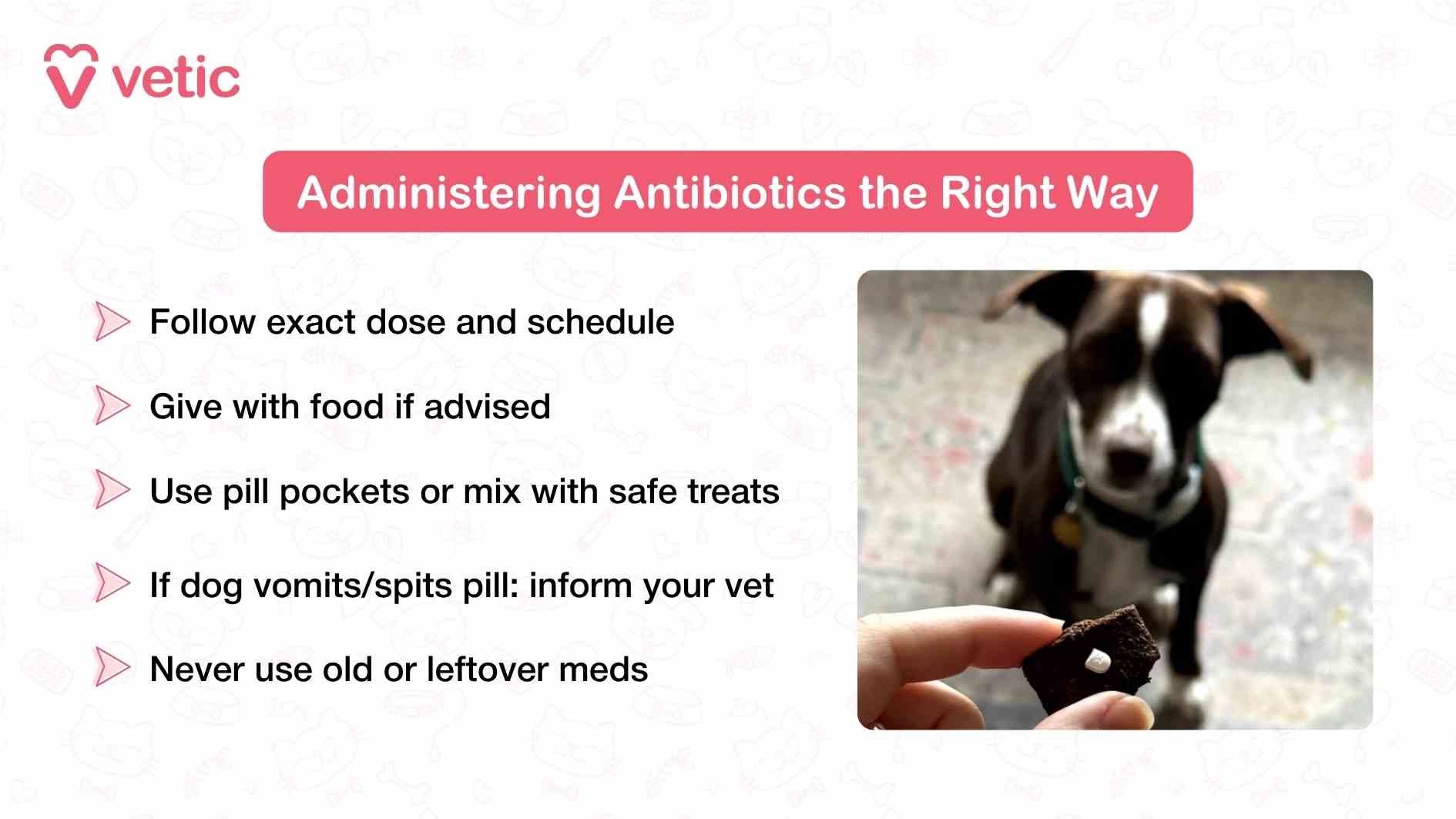
Antibiotics for dogs are medicines that treat bacterial infections by killing harmful bacteria or preventing their growth. They are essential in managing bacterial infections that could otherwise become severe or life-threatening.
Veterinarians prescribe dog antibiotics after assessing the infection type, severity, and bacterial strain involved. While some antibiotics overlap with those used in humans, not all are safe or effective for pets — dosage, duration, and formulation differ significantly.
Antibiotics do not treat viral, fungal, or parasitic diseases such as canine distemper, parvovirus, or mange. In viral cases, vets may prescribe antibiotics only to prevent secondary bacterial infections.
What Conditions Do Antibiotics Treat in Dogs?
Antibiotics are used to treat a wide range of bacterial infections in dogs. Below are the most common categories and how they’re managed.
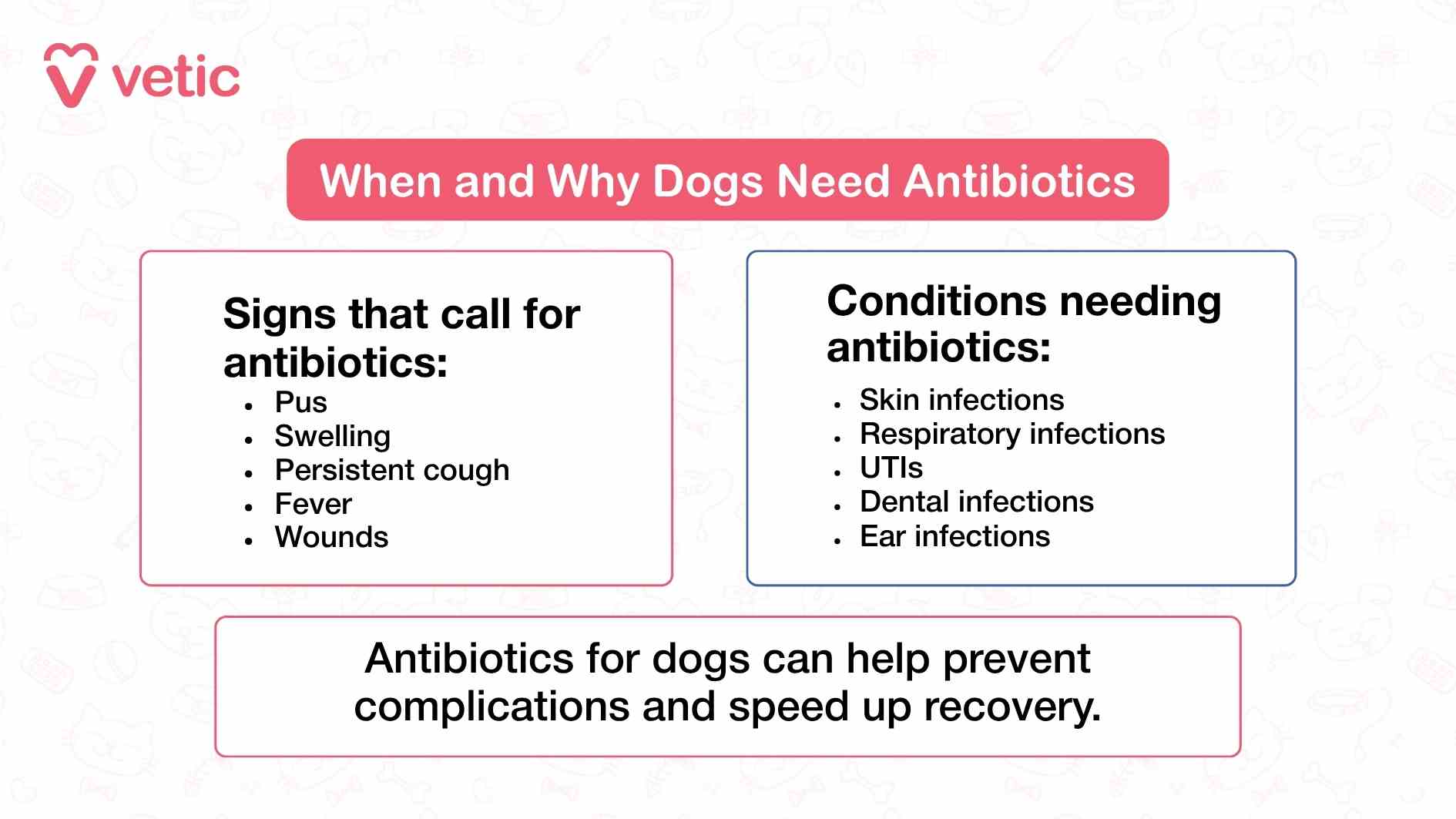
Skin Infections in Dogs
Dog antibiotics for skin infection (pyoderma) help manage bacterial overgrowth caused by wounds, allergies, parasites, or underlying conditions. Commonly prescribed antibiotics: Cephalexin, Clindamycin, Amoxicillin-clavulanate. Untreated infections can lead to abscesses or recurring hot spots, so veterinary guidance is crucial.
Urinary Tract Infections in Dogs
UTIs in dogs cause frequent urination, pain, or blood in the urine. These infections often require culture and sensitivity testing before starting treatment. Common antibiotics: Amoxicillin, Enrofloxacin, or Cephalexin. Always complete the full antibiotic course to prevent recurrence or resistance.
Respiratory Infections in Dogs
Coughing, nasal discharge, and difficulty breathing may signal bacterial respiratory infections or CIRDC. Antibiotics such as Doxycycline or Azithromycin are commonly used under veterinary supervision. Never self-medicate since respiratory signs can also indicate viral diseases like kennel cough or distemper.
Ear Infections in Dogs
Otitis externa or media (middle ear infections) are common in breeds with floppy ears. Dog ear infections may require topical antibiotic drops (containing Gentamicin or Ciprofloxacin) or oral medication. Proper cleaning and follow-up care are key to preventing recurrence.
Gastrointestinal Infections in Dogs
Antibiotics like Metronidazole or Amoxicillin may be prescribed for bacterial gastroenteritis or secondary infections caused by parasites. Overuse of these drugs, however, can disrupt healthy gut flora, so they should only be given when absolutely necessary.
Types of Antibiotics for Dogs
Each antibiotic works differently, and the right choice depends on the infection type and bacterial resistance profile.

Amoxicillin for Dogs
A broad-spectrum antibiotic used for skin, respiratory, and urinary infections. Often combined with clavulanic acid (as Amoxiclav or Clavam) to enhance effectiveness.
Cephalexin for Dogs
Commonly prescribed for dog skin infections and soft tissue wounds. Generally safe and effective, though it may cause mild digestive upset in some dogs.
Doxycycline for Dogs
Used to treat tick-borne diseases (Ehrlichiosis, Lyme), respiratory infections, and urinary tract infections. Should be given with food and never with dairy products.
Metronidazole for Dogs
Effective against anaerobic bacteria and protozoa. Often prescribed for diarrhea, colitis, and gastrointestinal infections. Overuse can cause neurological side effects, so always follow your vet’s directions.
Clindamycin for Dogs
Prescribed for dental, bone, and deep tissue infections. Works well against anaerobic bacteria and is sometimes used for post-surgical infection prevention.
Forms of Antibiotics for Dogs
Veterinary antibiotics come in multiple forms depending on the infection and your dog’s tolerance.
| Form | Pros | Cons | Examples |
| Tablets & Capsules | Easy to measure and store; accurate dosing. | Some dogs resist swallowing pills. May require food masking or pill pockets | Amoxicillin, Cephalexin, Doxycycline |
| Syrups & Liquids | Ideal for puppies or small dogs; easier to dose precisely. | Shorter shelf life; must be refrigerated in some cases. | Amoxicillin syrup, Metronidazole suspension |
| Ointments & Creams | Targeted relief for local skin or ear infections. | Dogs may lick off topical applications; use a cone collar if necessary. | Gentamicin ointment, Clindamycin cream |
| Injections | Provide faster results and guaranteed absorption, especially in severe infections or when oral medication isn’t possible | Must be administered by a veterinarian | Ceftriaxone injection, Amikacin injection, long-acting antibiotics |
Antibiotic Resistance in Dogs: What You Should Know
Antibiotic resistance occurs when bacteria adapt and stop responding to drugs that once killed them. It’s a growing problem in both human and veterinary medicine.
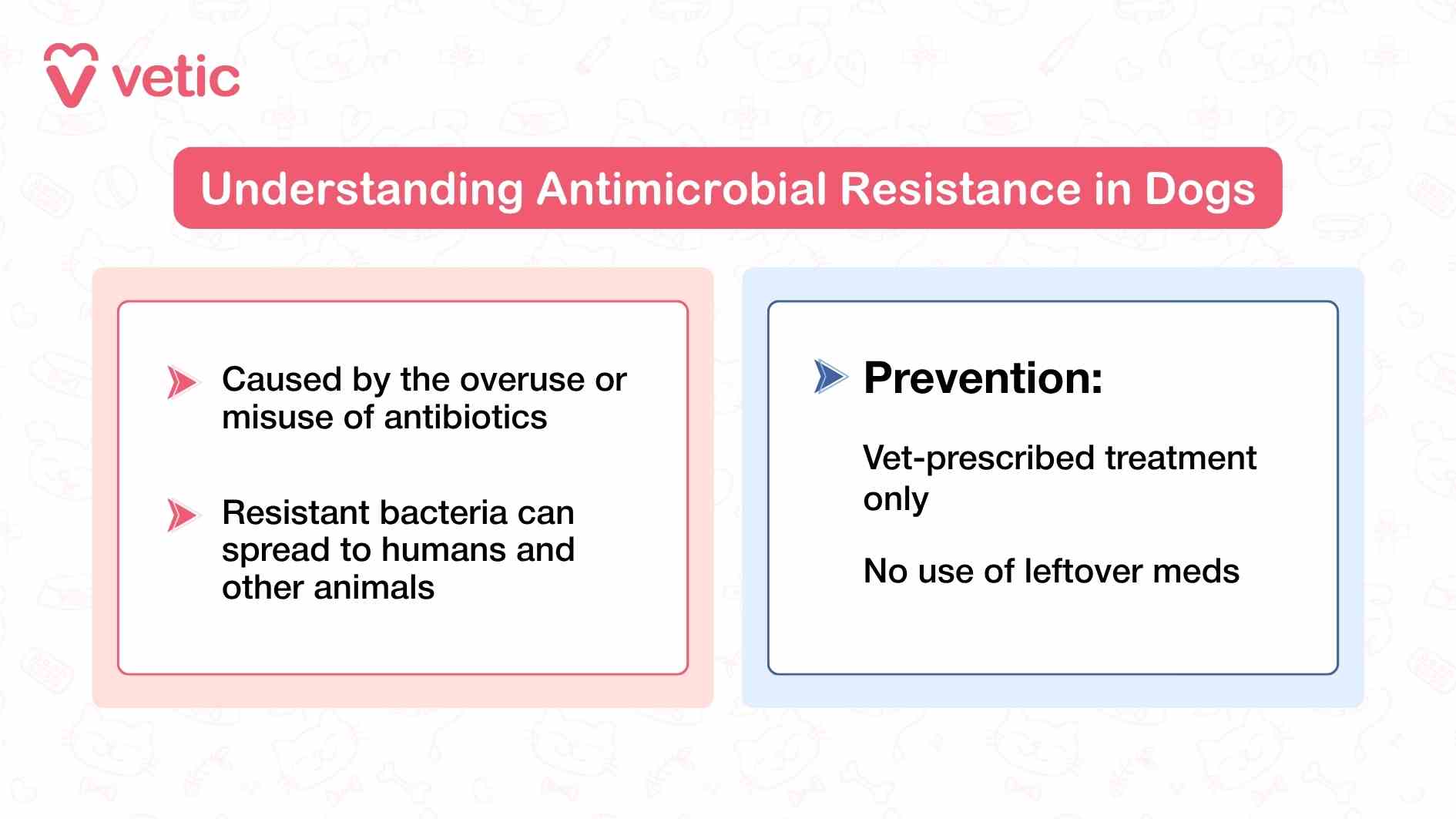
Causes of antibiotic resistance in dogs include:
- Overuse of the same antibiotic repeatedly
- Incorrect dosage or premature discontinuation
- Using leftover or expired medications
- Giving human antibiotics to dogs without a vet’s advice
To prevent antibiotic resistance:
- Always complete the prescribed antibiotic course
- Never self-medicate your dog
- Follow the exact dosage and schedule prescribed
- Dispose of unused medicine responsibly
Can Dogs Take Human Antibiotics?
Many pet parents ask, “Can I give my dog human antibiotics?” The answer: sometimes — but only under veterinary supervision.
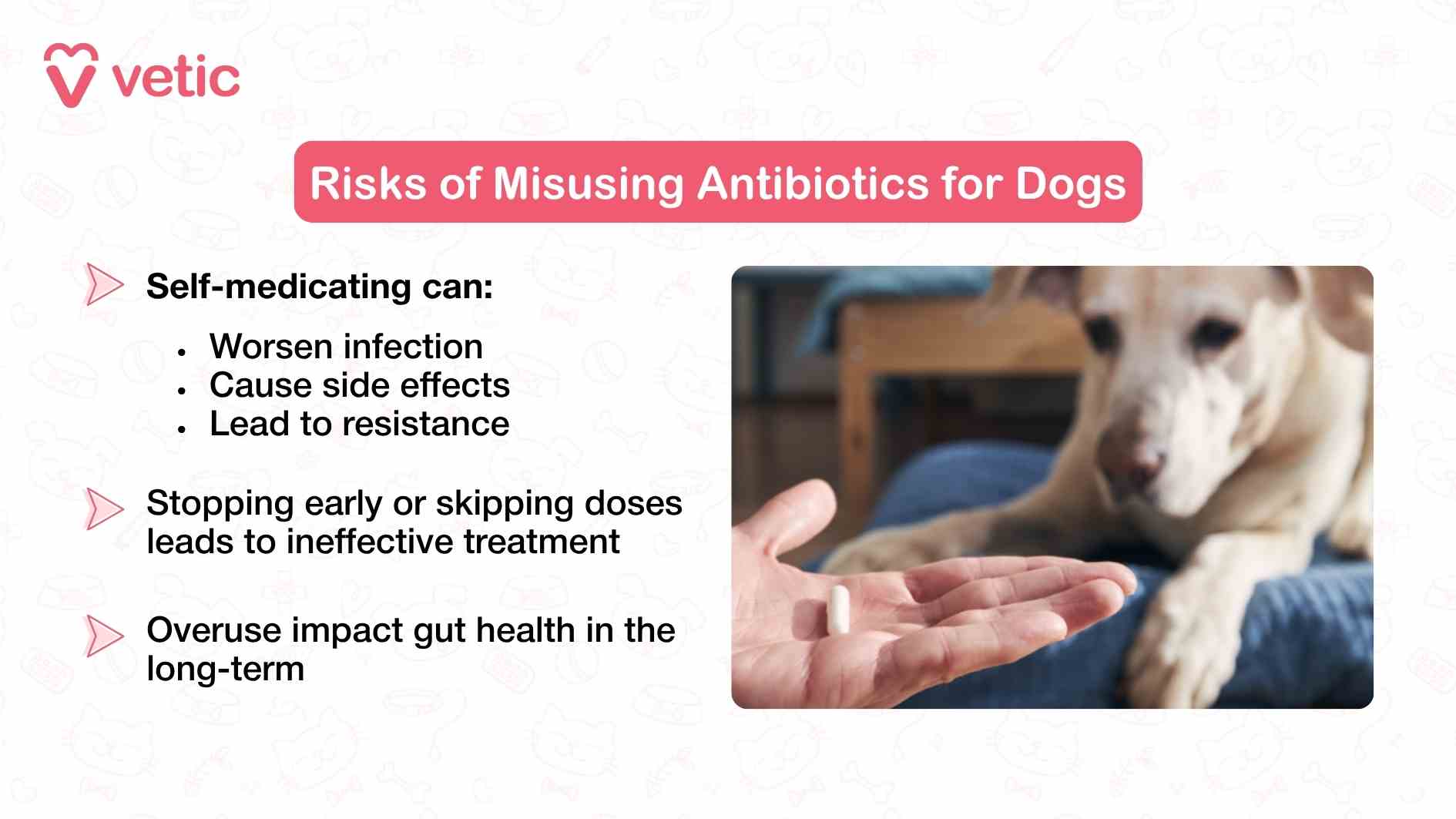
Certain human antibiotics like Amoxicillin, Cefixime, Doxycycline, and Metronidazole can be prescribed to dogs in adjusted doses. However, human concentrations are often too high for dogs, and incorrect dosing can lead to toxicity in dogs or treatment failure.
Never give antibiotics such as Ciprofloxacin, Linezolid, or Vancomycin without veterinary approval; these can cause severe side effects in dogs.
In short:
- Can dogs take human antibiotics? Only under vet guidance.
- Can you give human antibiotics to dogs? Never without a prescription.
- Antibiotic tablets for dogs and antibiotic injections for dogs must always be prescribed according to body weight and condition.
Common Side Effects of Antibiotics in Dogs
Antibiotics can save lives, but they also come with possible side effects. Most are mild and temporary, but some may require immediate medical care.
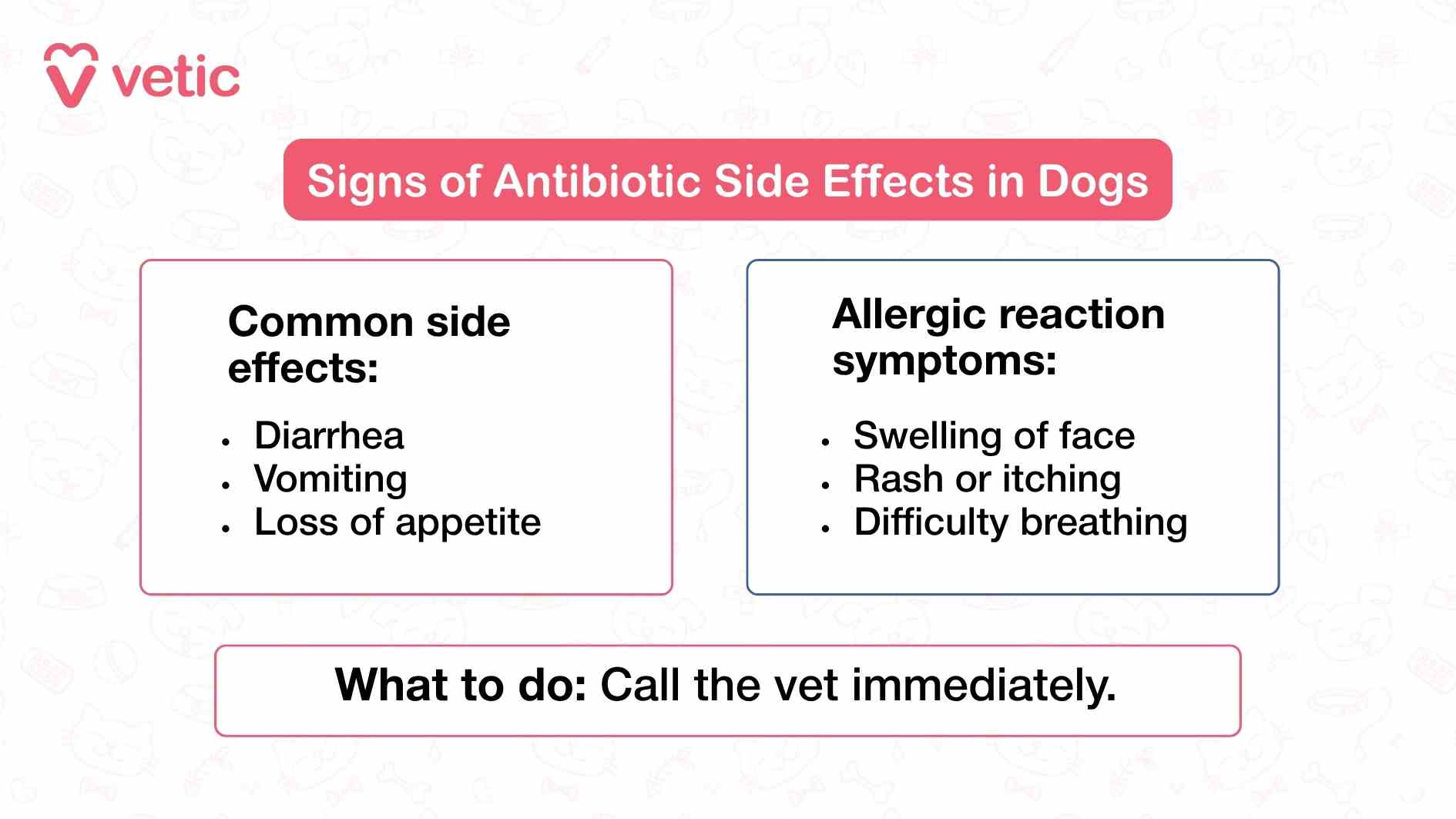
Vomiting and Diarrhea
A common reaction due to the disruption of gut bacteria. Probiotics are often recommended during antibiotic therapy.
Loss of Appetite
Your dog may eat less or seem disinterested in food. Offer bland meals like boiled chicken and rice, and keep your vet informed if it continues.
Allergic Reactions
Signs include swelling, itching, hives, or labored breathing. These may indicate an allergic reaction or anaphylaxis — seek emergency care immediately.
Behavioral Changes
Some dogs may appear lethargic, restless, or unusually quiet. Persistent behavioral changes should always be reported to your vet.
When You Should NOT Give Antibiotics to Your Dog
Avoid giving antibiotics in these situations unless explicitly advised by your veterinarian:
- Suspected viral, fungal, or parasitic infection (for example, parvo, ringworm, mange)
- Your dog recently completed an antibiotic course
- Dogs with liver or kidney disease where metabolism is impaired
- Concurrent medications that may interact with antibiotics
When in doubt, consult your vet before giving antibiotics to your dog.
Safe Use and Best Practices for Dog Antibiotics
To ensure your dog’s treatment is effective and safe:
- Use only vet-prescribed antibiotics
- Complete the entire course even if symptoms improve
- Store antibiotics as instructed (some require refrigeration)
- Watch your dog closely for side effects
- Never use leftover antibiotics or share medicines between pets
Your veterinarian may recommend follow-up tests to confirm that the infection has cleared completely. This step helps prevent relapse and reduces antibiotic resistance.
Conclusion
Antibiotics for dogs can be life-saving when prescribed and used correctly. But misuse, such as self-medicating with human antibiotics or stopping treatment early, can cause harm or contribute to drug resistance.
If your dog shows signs of infection, whether it’s a wound, persistent cough, or skin rash, consult your veterinarian right away. A qualified vet can identify the cause, prescribe the right antibiotic tablets, injections, or ointments, and ensure safe recovery.
Book a vet appointment with Vetic today to get expert guidance on safe antibiotic use and complete infection care for your dog.

